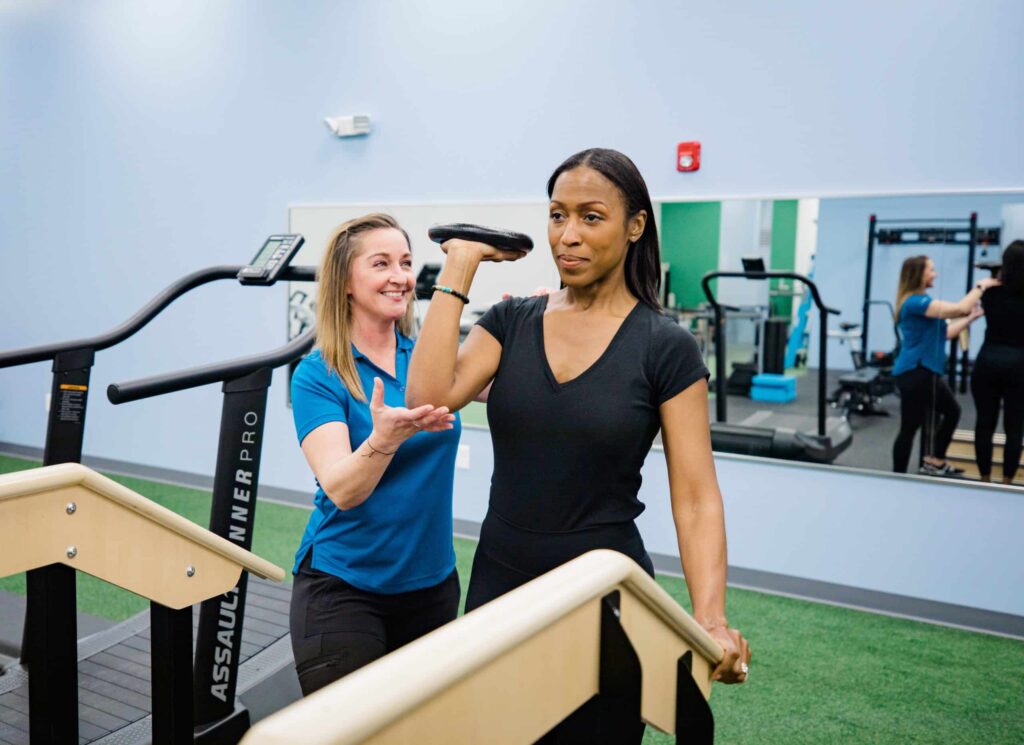Do you notice yourself slouching throughout the day? Is your knee pain getting worse when you run or do you have a stiff neck that won’t go away? Most people are sent to a physical therapist after a sports injury or rehabilitation following surgery. What you may not realize is physical therapy can help prevent aches and pains, maintain mobility and enhance overall wellness.
Having an interdisciplinary team improves patient outcomes, and there are many healthcare professionals you should enlist to be on your healthcare wellness team. Seeing a PT can be part of your wellness regimen even if you don’t have an injury. Especially if you train hard on a regular basis, or you’re elderly and worried about balance and coordination.
A physical therapist can teach you stretches and exercises as well as instruct on how to reduce inflammation through nutrition or ice. PTs know how to keep the body moving – this can go a long way in preventing injuries. These treatments also shorten recovery time and help manage arthritis and other degenerative conditions. A common myth is that physical therapy requires a referral or prescription. In most states, patients have direct access, meaning you can visit a physical therapist without going through your doctor.
Assembling Your Team
As you assess your health and gather a team of qualified professionals, these are people to include:
- You
- Your friends, family, caregivers
- Your primary care physician
- Nurse, home health aide
- Physical therapist
- Other specialists depending on your condition (surgeon, psychologist, urologist, cardiologist, etc)
How Your PT is a Vital Member To Your Healthcare Wellness Team
There are things a physical therapist can do that a doctor cannot or simply doesn’t have the time to address in a 15-minute office visit. In particular, physical therapists can quickly recognize postural distortion and offer exercises to keep the musculoskeletal system healthy. They assess habits that can lead to injury or chronic pain. Many PTs also have training in nutrition, massage techniques, posture and alignment, sports medicine and unique modalities like dry needling.
What Your Physical Therapist Can Do for You
1. Assess your injury risk: PTs can perform movement screens that identify where your weaknesses are and habits that can predispose you to injury.
2. Tailor a workout routine to you: PTs gather information about your habits, lifestyle, diet, body type, postural deficits, and overall health to develop appropriate activities for your age and fitness level. A physical therapist may recommend yoga over cycling for someone who sits all day, or glute and core exercises for marathon runners.
3. Speed up your recovery: PTs have a lot of tools in their toolbox, including alternative therapies, lifestyle tips, and specialized clothing. Compression socks, foam rolling, and massage can improve circulation and reduce inflammation and swelling.
4. Correct alignment and postural issues: Repetitive movements like running, hunching forward, carrying a heavy purse on one shoulder or sleeping with your neck tilted to one side can create imbalances, kinks and muscle tension. Over time, bad posture can throw your alignment off and lead to weakness, numbness, and pain. PTs can identify your specific issues and suggest exercises and relaxation techniques to relieve nerve blockages and restore mobility.
5. Help you avoid or recovery from surgery: Many doctors send patients to specialists who then recommend surgery, but PTs can teach you how to make small changes in your daily routines. Simple things like becoming aware of how you sit, sleep, walk or respond to stress can make a difference. Some surgeons order PT as part of prehab or encourage patients to try it before going through surgery.
Prevention & Collaboration Improves Patient Outcomes
Similar to having a yearly checkup, or calling your psychologist during a crisis, many people “check-in” with their physical therapist. They view PT as preventative medicine since many postural issues, along with chronic pain, develop over a period of time. This helps to identify and correct problems before they start.
For some, cost and other commitments can make routine visits impractical. But it may be worth a visit to a physical therapist before training for a triathlon or taking up a strenuous activity to avoid injury. Physical therapists teach exercises and create individual plans that improve mobility and alignment required for optimal physical function. PTs also can identify underlying dysfunctions, such as muscle tightness, tingling and reduced range of motion, before pain or an injury is present.
Others go through a referral as part of a continuum of care, and doctors and surgeons play an important role in explaining the benefits of physical therapy. There are many ways inter-professional collaboration promotes patient-centered care. You should seek out a healthcare wellness team that stays in communication and collaborates to address your concerns. This can prevent missed symptoms, lethal drug interactions and side effects, or a flare-up of an old injury.
The Missing Link
Total-body wellness encompasses mind, body and spirit and each medical professional holds a piece of the puzzle. Physical therapy is often the missing link. Patients go from diagnosis to surgery and then struggle to get back to healthy living if they don’t get PT. Or they may get unnecessary medication or surgery for a problem that could have been resolved if they had gone to PT first. This can lead to long-term pain and issues with movement, along with an expensive hospital bill and months of recovery.
Finding the right physical therapist can take time, but they can be an important member of your healthcare wellness team and crucial to your recovery. With more than 100 clinics and highly skilled professionals, Ivy Rehab Network offers an array of specialized services that go beyond traditional physical therapy. Aquatic therapy, orthopedic therapy, McKenzie Method, soft tissue mobilization and post-surgical treatments are among the arsenal of non-invasive techniques available.
October is National Physical Therapy Month. Take time to make an appointment for that nagging pain or check in with your favorite Ivy Rehab Network physical therapist. We are here for you whenever you need us!







